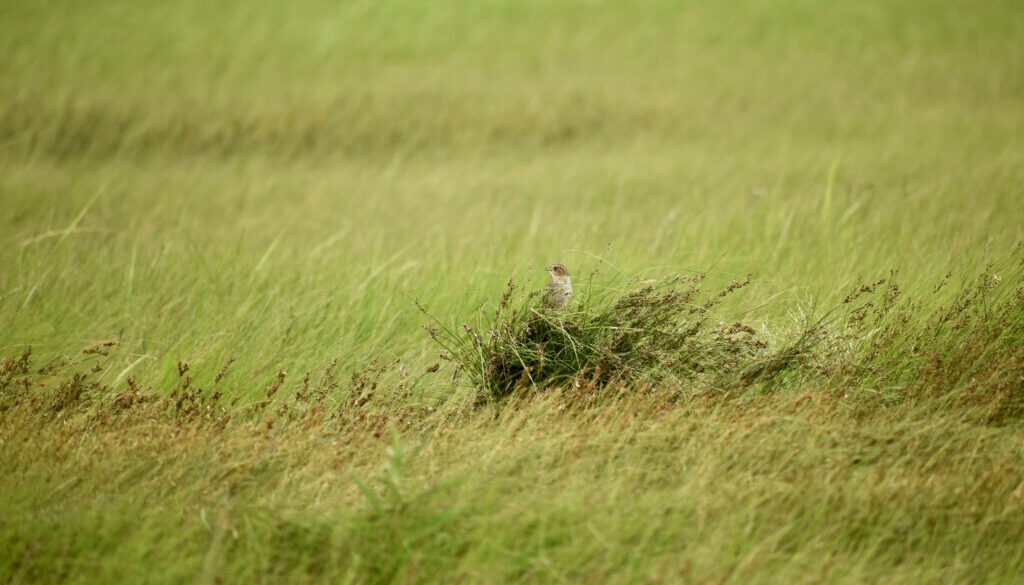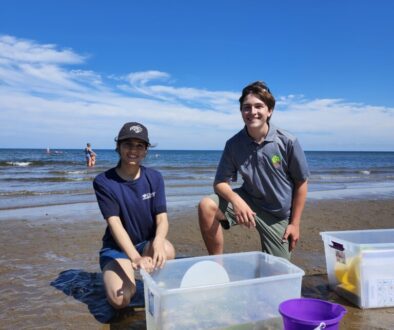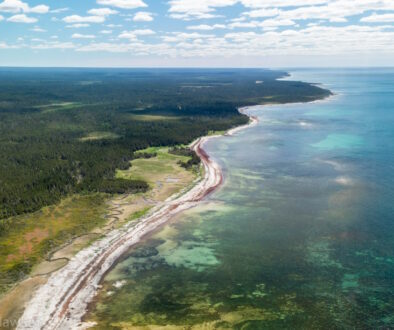Tracking Nelson’s Sparrows on the Salt Marshes of the Bay of Fundy
by Meghan Oliver
When you think about the wildlife of the Bay of Fundy, images of whales breaching in the ocean, seals sunbathing on the rocks, or flocks of shorebirds in the mudflats might come to mind. However, Kiirsti Owen – a PhD candidate at the University of New Brunswick and Acadia University – might picture a Nelson’s Sparrow darting through the grasses of the salt marshes that surround the Bay. Her research has brought her up-close to this cryptic species of songbird and she has become quite attuned to their unique traits.
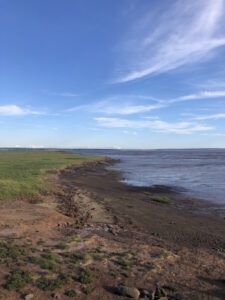
“They’re not a very striking bird visually…but their sound is really cool!” explained Kiirsti. Their song is truly unique as it doesn’t sound like the melodic chirping of most birds. It was described to her as the noise a pop can makes when it opens, and that description has stuck.
Behaviour-wise, Nelson’s Sparrows aren’t quite bird-like either. They stay fairly low to the ground, and Kiirsti described their movements as more rodent than bird. They will often scurry around the grass and fly short distances before landing back into the thick vegetation.
As part of her doctoral research, Kiirsti has spent the last two summers studying these birds in the salt marshes near Sackville, New Brunswick, and this part of the province is the optimal area to address one of her main research questions: how do wetland birds use human-created landscapes? This is because of the prevalence of agriculture in the region. Dykes were constructed in parts of the salt marsh so the nutrient-rich soil could be used for farming, and the presence of both salt marshes and agricultural land allows Kiirsti to compare the ways that Nelson’s Sparrows use these natural and human-made landscapes, respectively.
Nelson’s Sparrows are typically considered a “salt marsh specialist”, meaning their breeding habitat is usually limited to salt marshes. However, this Maritime population of sparrows also nests in the agricultural land that lies inland, and Kiirsti isn’t sure why these birds choose to breed outside of the marsh.
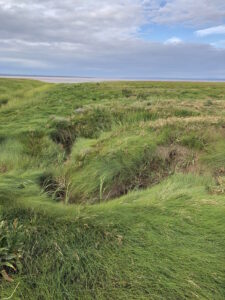
To investigate this, Kiirsti tracks the movements of Nelson’s Sparrows using radiotelemetry. In short, she attaches lightweight transmitters to the birds. Each transmitter emits a unique radio signal which can then be picked up by a handheld receiver. By trudging around the salt marsh and agricultural land, Kiirsti and her team can resight the birds and map their movements, ultimately revealing the habitats that the birds prefer.
Her days tracking birds can be long and demanding; in the height of the breeding season, her and her team wake up around 3:30 AM and are already busy at work before the sun comes up. The uneven terrain and abundance of water can make it difficult to navigate around her study sites, but Kiirsti’s fondness for the salt marshes and the sparrows that are able to subsist there is incredibly apparent.
“Salt marshes look like such a benign landscape, but once you start working it you realize that this is a harsh environment,” she commented. “It takes a lot for something to be able to make it there.”
This challenge of surviving in such a salty environment would be difficult on its own, but the population of Nelson’s Sparrows that Kiirsti studies has the added difficulty of dealing with the high tides that are emblematic of the Bay of Fundy. When the tide comes in, the salt marsh can flood and the nests of the sparrows – which are on the ground – could be inundated. With water levels rising due to climate change, birds that nest in the salt marsh could have higher instances of nest failure due to flooding compared to those that nest in the agricultural land. As such, it will become increasingly important to understand the factors that determine how birds select nesting habitat.

“Maybe the salt marsh is really important habitat now for Nelson’s Sparrows,” Kiirsti said, “but are they going to be successful 50 years from now in the same spots if the sea level keeps rising?”
While Kiirsti’s research highlights one way that the salt marshes of the Bay of Fundy are useful for wildlife, there are many more instances that illustrate the services that this ecosystem offers. Not only do they provide habitat for many organisms, but salt marshes also protect and stabilize coastlines, filter sediments and pollutants, sequester carbon, provide nutrients, and minimize the effects of ocean acidification on local areas. In fact, these coastal protection benefits may also help to mitigate the threats faced by the wildlife that use the salt marshes.
In a landscape facing agricultural development, restoration efforts, and a changing climate, studies like Kiirsti’s will allow us to understand how and why animals like the Nelson’s Sparrow use these salt marshes in the Bay of Fundy. While her current findings suggest that these birds prefer the salt marsh over human-made landscapes, it’s unclear if this affinity will change in the coming decades. However, the ecosystem services provided by salt marshes are clear, and by protecting these landscapes, we can in turn protect these benefits for the decades to come.
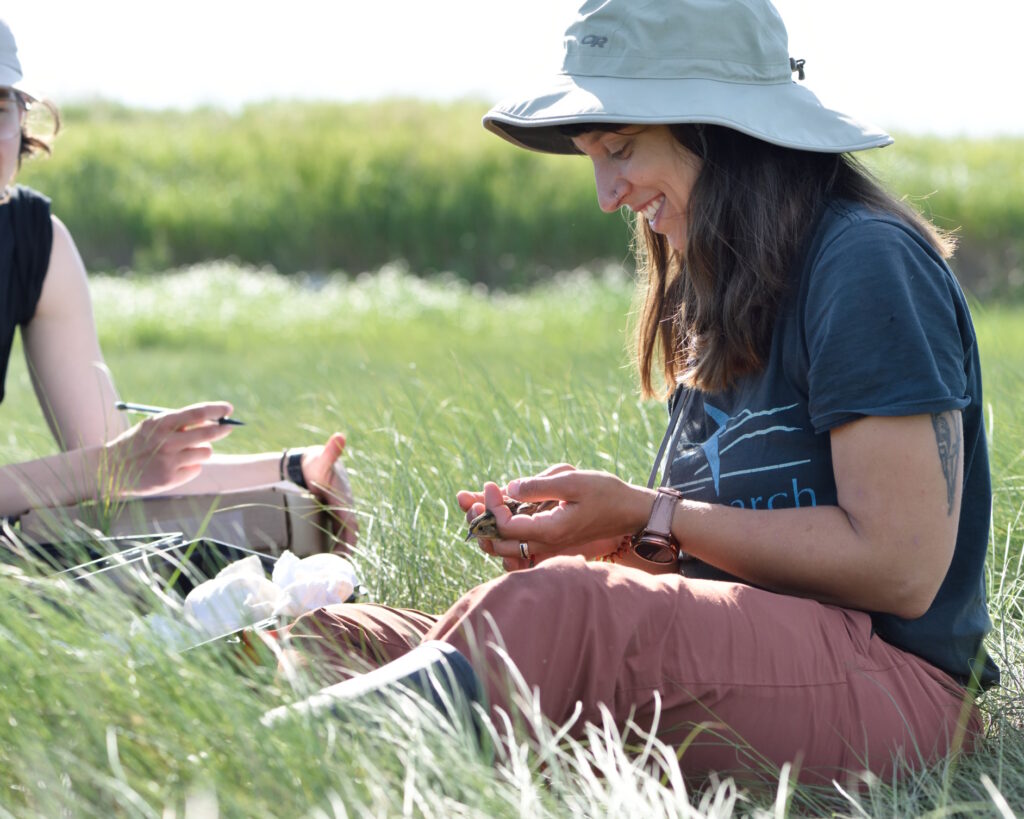
Banner photo: A male Nelson’s Sparrow in the Beausejour Marsh near Sackville, NB. (Photo credit: Kiirsti Owen)

